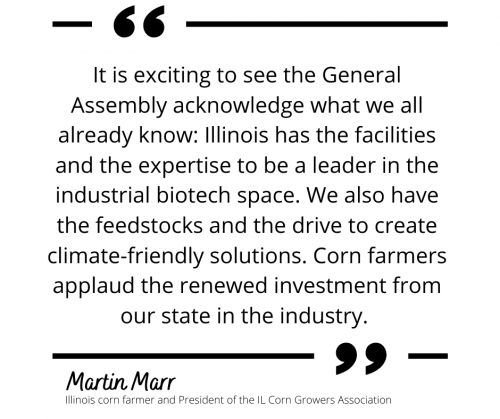Illinois Legislation Allows More Aggressive Development of IL Industrial Biotech Industry

Last week, the Illinois General Assembly sent a signal that Illinois is ready to designate itself as the premiere location for industrial biotechnology companies and innovation.
SB 1693, the Illinois Industrial Biotechnology Partnership Act, sponsored by Lance Yednock (D-Ottawa) and Sen. Scott Bennett (D-Champaign) capitalizes on previous investments in Illinois’ biotech research and infrastructure and creates the Illinois Industrial Biotechnology Partnership, a public private partnership to help market Illinois to the growing industrial biotech sector.
Industrial biotechnology includes modern application of biotechnology for sustainable processing and production of biobased chemical products, materials, and fuels.
“It is exciting to see the General Assembly acknowledge what we all already know: Illinois has the facilities and the expertise to be a leader in the industrial biotech space. We also have the feedstocks and the drive to create climate-friendly solutions. Corn farmers applaud the renewed investment from our state in the industry,” said Martin Marr, Illinois corn farmer and President of the IL Corn Growers Association.
In recent years, competition from border states has kept industrial biotech companies from siting in Illinois. Many neighbor states are actively recruiting the companies, with one company locating in Iowa to produce a biorenewable chemical that was developed in Illinois.
Illinois cannot afford to lose out on these types of important growth opportunities.
The effort to recruit and site new companies within our state could support as many as 15 firms producing new products, offering as many as 6,700 new jobs, $515 million in new earnings for Illinois workers, and as much as $91.5 million in new tax revenue.
The bill creates individual Funds for the hiring and retention of experts needed in Illinois research facilities, maintenance and expansion of those facilities, and expands our existing workforce in this space.
“The heavy lifting has been done. Illinois has already made significant capital investments to support this industry – these investments in our current research facilities give us a unique advantage that is unmatched anywhere else in the country,” said Representative Yednock in his testimony.
The bill current waits for the Governor’s signature.
IL Corn is grateful to the Illinois Soybean Association, Illinois Farm Bureau, Illinois universities and Illinois manufacturing and processing industries for their partnership on this bill.






